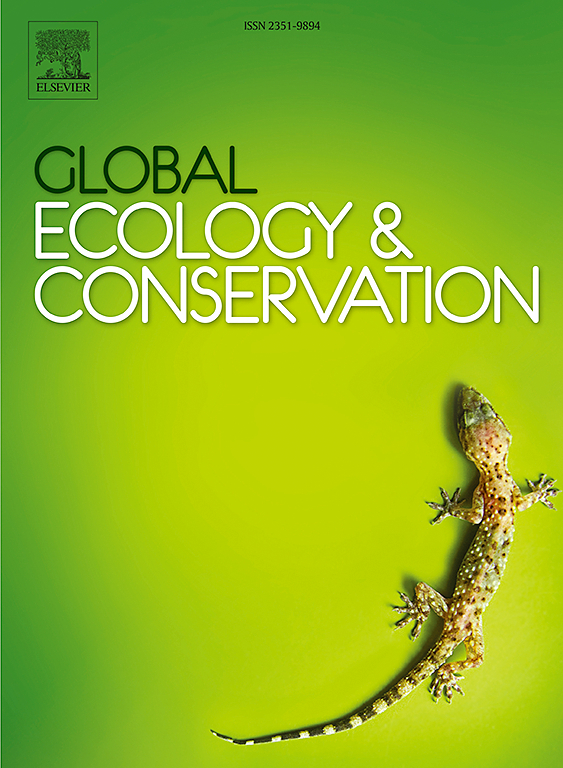基于土壤edna的液滴数字PCR检测作为陆生哺乳动物监测的新工具
IF 3.4
2区 环境科学与生态学
Q1 BIODIVERSITY CONSERVATION
引用次数: 0
摘要
本研究证明了液滴数字PCR (ddPCR)从土壤来源的环境DNA (eDNA)中鉴定脊椎动物分类群的有效性,这是一种以前没有文献记载的方法组合。对该方案进行了优化,以检测小盲鼹鼠(BMR)的隐种。在塞尔维亚12个地区共收集了5个隐种BMR的38个土壤样本。基于细胞色素b (cytb)基因设计了物种特异性引物/探针组。优化ddPCR检测方法并验证引物/探针特异性后,将所有样本分三份扩增,并使用RStudioV4.3.3 Environment检测结果的显著性。38份样品中有33份检测到阳性结果(86.84 %),突出了ddPCR在检测和定量土壤样品中稀有和降解目标DNA方面的优势。浓度范围为0.073 ~ 236 copies/µL。引物/探针组具有高度特异性,唯一的困难是区分两个系统发育上最接近的隐物种,但特异性(目标)和非特异性(非目标)隐物种的荧光振幅存在差异。基于土壤edna的ddPCR物种鉴定是一种快速、高灵敏度的无创监测方法。它可以在广阔的区域内对许多地点进行快速简便的采样,为保护管理提供必要的数据。该议定书为针对隐蔽物种的保护战略提供了一个有价值的框架,同时也为其他令人关注的陆生脊椎动物(特别是那些受到严格保护或被列为濒危物种的动物)的适应和更广泛实施奠定了基础本文章由计算机程序翻译,如有差异,请以英文原文为准。
Soil eDNA-based droplet digital PCR assay as a new monitoring tool for terrestrial mammals
This study demonstrates the effectiveness of droplet digital PCR (ddPCR) for identifying vertebrate taxa from soil-derived environmental DNA (eDNA) a methodological combination not previously documented in literature. The protocol is optimized for detecting cryptic species of the lesser blind mole rat (BMR). A total of 38 soil samples were collected from five cryptic BMR species across 12 localities in Serbia. Species-specific primer/probe sets were designed based on the cytochrome b (cytb) gene. After optimization of ddPCR assays and verification of primer/probe specificity, all samples were amplified in triplicates and the results’ significance was tested using the RStudioV4.3.3 Environment. The total number of positive findings was detected in 33 out of 38 samples (86.84 %), highlighting the strength of ddPCR in detecting and quantifying rare and degraded target DNA from soil samples. Concentration values varied from 0.073 to 236 copies/µL. The primer/probe sets were highly specific and the only difficulty emerged in distinguishing between two phylogenetically closest cryptic species, but with a discrepancy in fluorescence amplitudes in specific (target) and non-specific (non-target) cryptic species. We have confirmed that soil eDNA-based ddPCR species identification is a fast and highly sensitive non-invasive monitoring method. It allows quick and easy sampling of many locations across wide areas, providing essential data for conservation management. This protocol offers a valuable framework for conservation strategies targeting cryptic species, while also serving as a foundation for adaptation and broader implementation across other terrestrial vertebrates of concern – particularly those that are strictly protected or classified as endangered.––
求助全文
通过发布文献求助,成功后即可免费获取论文全文。
去求助
来源期刊

Global Ecology and Conservation
Agricultural and Biological Sciences-Ecology, Evolution, Behavior and Systematics
CiteScore
8.10
自引率
5.00%
发文量
346
审稿时长
83 days
期刊介绍:
Global Ecology and Conservation is a peer-reviewed, open-access journal covering all sub-disciplines of ecological and conservation science: from theory to practice, from molecules to ecosystems, from regional to global. The fields covered include: organismal, population, community, and ecosystem ecology; physiological, evolutionary, and behavioral ecology; and conservation science.
 求助内容:
求助内容: 应助结果提醒方式:
应助结果提醒方式:


